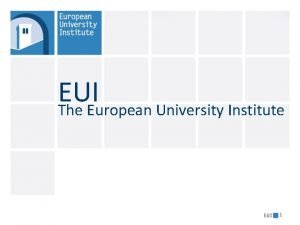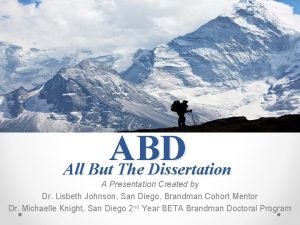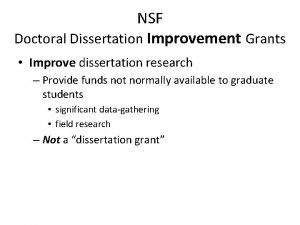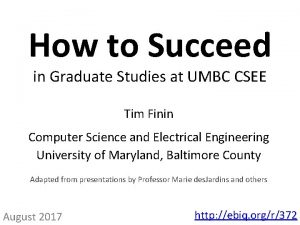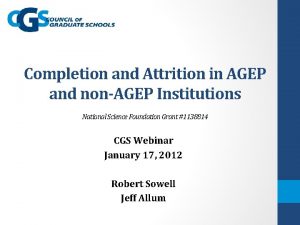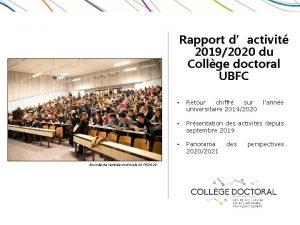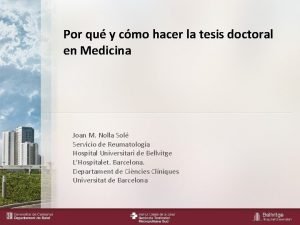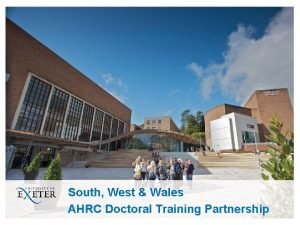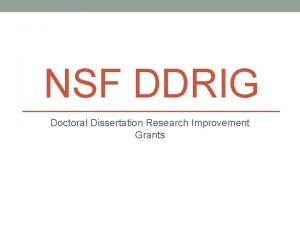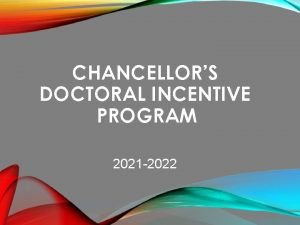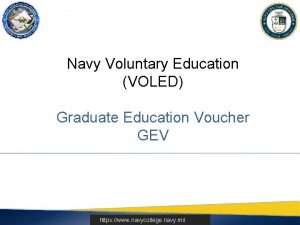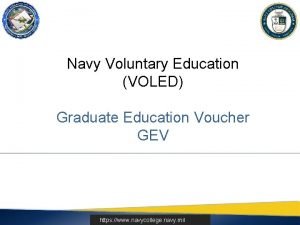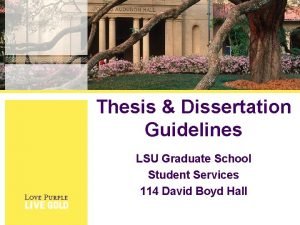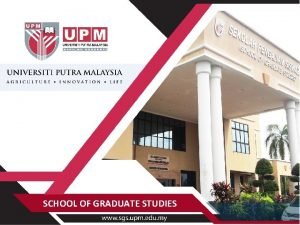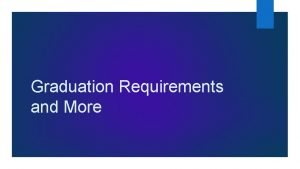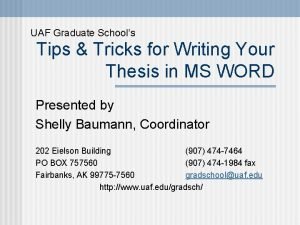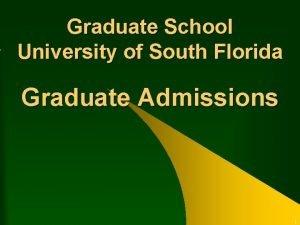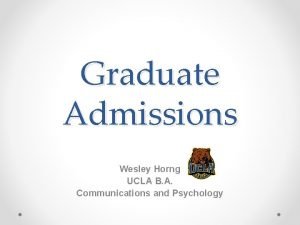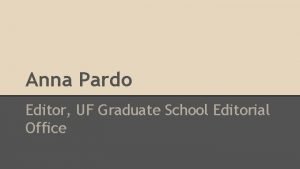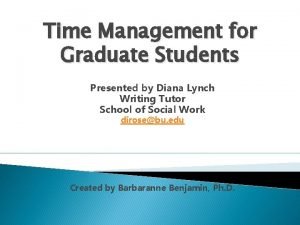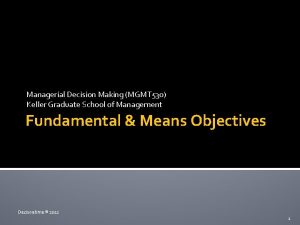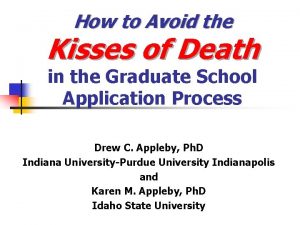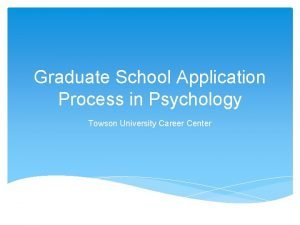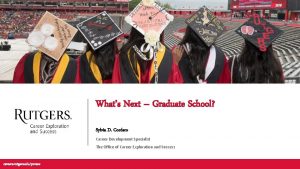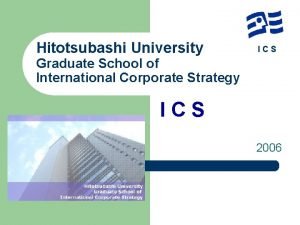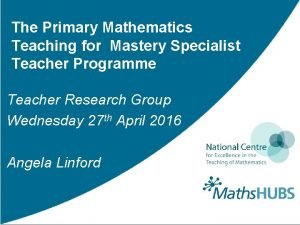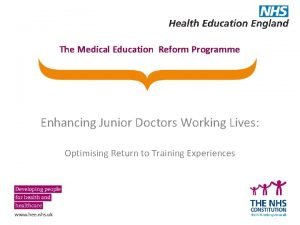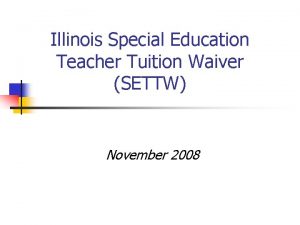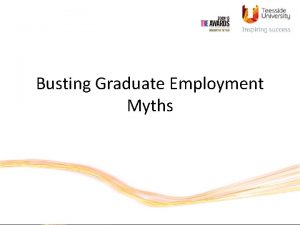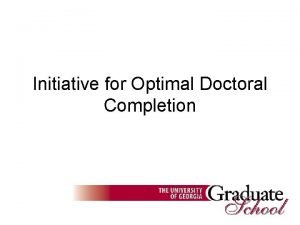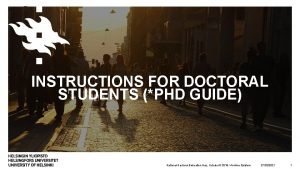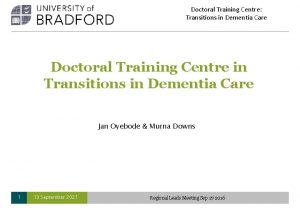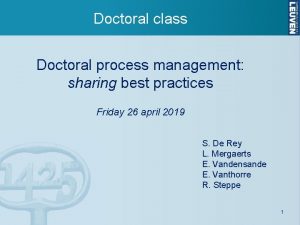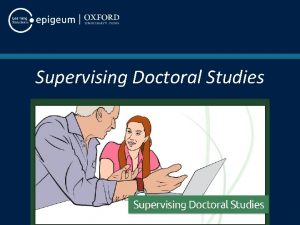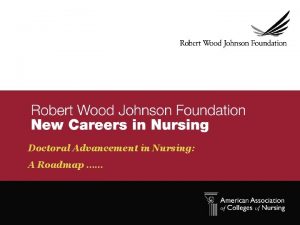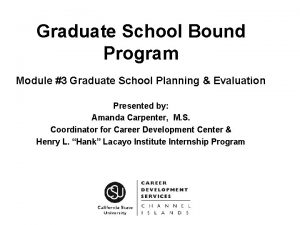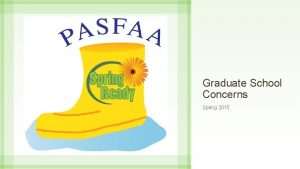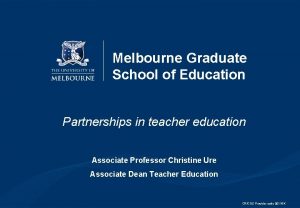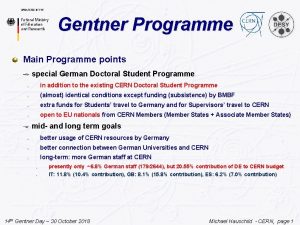Graduate Teacher Education Programme Doctoral School Programme outline






































- Slides: 38

Graduate Teacher Education Programme Doctoral School

Programme outline • Day one – Welcome, introductions & personal goals for the programme – How do students learn? – Planning for active learning – Small group teaching – Large group teaching – Planning activity

Programme outline • Day two – Assessment and giving feedback to students – Developing effective learning environments – Supporting students in distress – Applying for Professional Recognition with the HEA – Programme summary, evaluation and close

Programme learning outcomes On completion of this programme you should be able to; – Plan effectively for active learning in large and small group teaching – Confidently deal with challenging situations in the classroom – Participate in the assessment of students and provide constructive feedback to help them learn successfully

Programme learning outcomes – Make appropriate use of inclusive learning resources and the virtual learning environment to support student learning – Understand the requirements for making an application for Associate Fellowship of the Higher Education Academy

Programme team • • Dr Kelly Sisson Dr Jonathan Cooper Jasper Shotts Dr Kirsty Miller Ellie Forbes Jacqueline Mayer Maeve O’Dwyer

Introductory round • Please introduce yourself to the rest of the group – Your name & School – Your area of research – Whether you have any previous experience of teaching and supporting learning

Hopes and fears • Take two different coloured post it notes • On one record your hopes for this programme – What do you hope to learn about in the next two days? • On the other record your fears in relation to teaching in HE • Be prepared to share your thoughts with the group

How do students learn?

Session learning outcomes • On completion of this session you should be able to; – Identify factors that create a positive learning experience – Understand key principles of constructivist learning theory

What helps you to learn? • Think of an example of your own successful learning – or a positive learning experience you have had • Make notes on the following; – – What factors helped you to learn? What did the teacher do? What did you do? What was the learning environment like? This does not have to be learning in an academic environment

What does the literature say? • Students learn best when they construct their own knowledge instead of having someone construct it for them • Underpinned by constructivist learning theory – Learning is an active process of creating meaning from different experiences – Students learn best by doing, and trying to make sense of something on their own with the teacher as a guide to help them (Brooks & Brooks, 1993)

Principles of constructivist learning theory By applying theory to real world problems When they have opportunities to reflect When learning is active How do students learn best? Through solving problems When they are involved in the process of inquiry & discovery

Planning for Active learning

Session learning outcomes • On completion of this session you should be able to; – Identify the factors that influence your approach to planning – Ensure that learning outcomes, activities and assessments are appropriately aligned – Structure teaching sessions to provide maximum opportunity for learning

FACTORS THAT INFLUENCE PLANNING

Scenario • You have been asked to deliver a session on a topic that is slightly outside of your comfort zone to a group you have not previously met – What would you need to know in order to plan an effective session for this group? – How would you typically go about planning this session?

Factors that influence planning • Context – Who are your students? Full time/part time; new to HE/returning to HE; cultural mix • Level – First year? Postgraduate? • Previous knowledge – What do they already know? Where should you start from? • Content/ topics – What is the new material that you hope to introduce to them? What is essential? What is desirable?

Approaches to planning (Fry et al, 2006) Type of approach Description Systematic Proceeds from identifiable needs to predictable (learning) outcomes. Also known as outcomes-based planning Intellectual Places primary emphasis on the disciplinary content and examines the body of information, attitudes and skills student will need to know Problem-based Identifies one or more specific problems to be addressed, not defined by objectives and emphasises the process of understanding the problem Creative/experiential Involves teaching/learning by experience and generally through the dynamics of group process. Training/workshop-based Outcomes are defined by the skills acquired through the training workshop

The systematic approach and outcomes-based planning • The specification of outcomes if the first step in the systematic approach • Shifts the focus from the knowledge base of the teacher to the knowledge needs of the student • A more learner centred approach

Outcomes based planning Plan outcomes Revision Sequence topics Assess the outcomes Assess student characteristics Implement Design the learning activities

Advantages of outcomes based planning • It allows teachers to clarify for themselves the implicit outcomes that are always part of any teaching and learning activity • It allows for reflection on all aspects of pedagogical practice • It allows students to have a clearer understanding of what they can expect – This in turn increases motivation which can lead to improved performance

Matching learning outcomes, activities and assessment • Matching learning outcomes, activities and assessment optimises the conditions for quality learning • This is known as constructive alignment – Constructive = students construct meaning through relevant learning activities – Alignment = how the teacher sets up the learning environment


Group activity • Read through the given learning outcomes • For each one identify – An appropriate learning activity or activities – An appropriate method of assessing student learning

STRUCTURE FOR LEARNING

Pay attention! How long can you reasonably expect your students to pay attention for in class?

What do we know about attention? • The exact length of the average attention span is very hard to accurately measure (Wilson & Korn, 2007) and not known • Lapses in attention occur frequently • Very short lapses in attention are more common than longer breaks • Lapses in attention occur more frequently as the session progresses

Attention and active learning • There is a strong relationship between attention and active learning • Attention is less likely to lapse when students are engaged in active learning • Students are more attentive during active learning and immediately afterwards

What are the implications for planning? • Sessions are most effective when periods of the tutor talking are broken up with periods of active learning • We should expect lapses in attention and plan accordingly

Sample lesson plan

Sample lesson plan

Pay attention! • How can you maintain the attention of your students throughout the session? – What might you do at the start to capture their attention? – What might you do at the end?

Strategies for capturing attention • • • Change the level and tone of your voice Use props or visuals Make a startling statement or give a quote Write a challenging question on the board Play music Choose relevant examples

Strategies for capturing attention • Teach at the right level of difficulty • Use humour – even if it’s a joke about yourself • Establish the routine, task and time limit • Plan carefully and make this visible to students (SIGNPOSTS) • Tell stories

Some thoughts about beginnings and endings Beginnings Endings • Setting the scene • Make links • Find out what they know • Arouse interest • • Assess learning Make links Evaluate the session Say farewell

One minute paper • How will the material we have covered this morning change the way you approach your teaching practice?

References • Biggs, J. (2003) Aligning teaching and assessment to curriculum objectives. LTSN: Generic centre. • Brooks, J. G & Brooks, M. G. , (1993) In search of understanding: The case for constructivist classrooms. Alexandria: Association for supervision and curriculum development. • Fry, H. , Ketteridge, S. & Marshall, S. (2003) A handbook of Teaching and Learning in Higher Education. (2 nd Ed). London: Routledge Falmer. • Wilson, K. & Korn, J. H. (2007) Attention during lectures: Beyond ten minutes. Teaching of Psychology. 34 (2) 8589
 Eui doctoral programme
Eui doctoral programme Abd dissertation
Abd dissertation Nsf dissertation improvement grant
Nsf dissertation improvement grant Umbc doctoral programs
Umbc doctoral programs Doctoral initiative on minority attrition and completion
Doctoral initiative on minority attrition and completion College doctoral ubfc
College doctoral ubfc Power point tesis doctoral medicina
Power point tesis doctoral medicina South west doctoral training partnership
South west doctoral training partnership Doctoral dissertation research improvement grants
Doctoral dissertation research improvement grants Csu doctoral incentive program
Csu doctoral incentive program Gev navy
Gev navy Graduate education voucher
Graduate education voucher Lsu thesis statement
Lsu thesis statement School of graduate studies
School of graduate studies Kupid portal
Kupid portal High school honor graduate requirements georgia
High school honor graduate requirements georgia Himalayan graduate school of theology
Himalayan graduate school of theology Uaf thesis format
Uaf thesis format Usf applicant portal
Usf applicant portal Nau graduate assistantships
Nau graduate assistantships Ucla graduate school
Ucla graduate school Anna pardo
Anna pardo Ajou university graduate school of international studies
Ajou university graduate school of international studies Oussep osaka
Oussep osaka Time management for graduate students
Time management for graduate students Keller graduate school of mgmt
Keller graduate school of mgmt Kisses of death for the graduate school application
Kisses of death for the graduate school application Nau graduate college
Nau graduate college Twente graduate school
Twente graduate school Towson university psychology
Towson university psychology Sylvia cordero
Sylvia cordero Ics graduate school
Ics graduate school Primary mathematics specialist teacher programme
Primary mathematics specialist teacher programme Sandwich sentence writing
Sandwich sentence writing Erf promotion
Erf promotion Afternoon teacher
Afternoon teacher Medical education reform programme
Medical education reform programme Spartans physical education
Spartans physical education Special education tuition waiver
Special education tuition waiver
